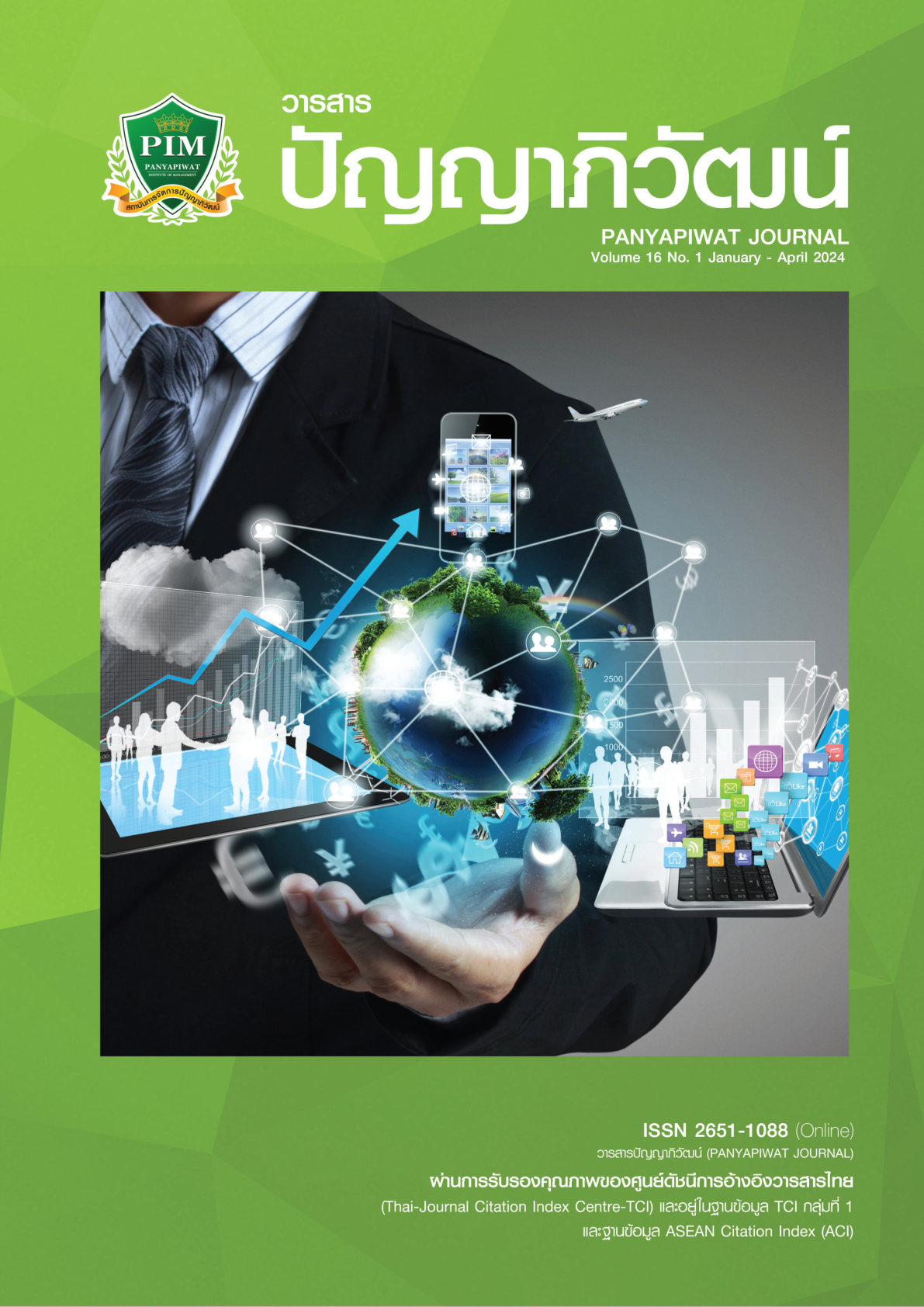อิทธิพลภาวะผู้นำการเปลี่ยนแปลง การจัดการนวัตกรรมเชิงกลยุทธ์ ที่ส่งผลต่อผลการดำเนินงานของธุรกิจ: กรณีศึกษาธุรกิจผลิตเซรามิกขนาดกลางและขนาดย่อมในจังหวัดลำปาง
Main Article Content
บทคัดย่อ
การศึกษาครั้งนี้มีวัตถุประสงค์เพื่อหาความสัมพันธ์เชิงสาเหตุของอิทธิพลของภาวะผู้นำการเปลี่ยนแปลงการจัดการนวัตกรรมเชิงกลยุทธ์ที่ส่งผลต่อผลการดำเนินงานของธุรกิจ: กรณีศึกษาธุรกิจผู้ผลิตเซรามิกขนาดกลางและขนาดย่อมในจังหวัดลำปาง เก็บข้อมูลโดยใช้แบบสอบถาม ประชากรคือ ผู้ประกอบการหรือผู้จัดการของธุรกิจผลิตเซรามิกขนาดกลางและขนาดย่อมในจังหวัดลำปาง จำนวน 159 คน
โมเดลอิทธิพลของภาวะผู้นำการเปลี่ยนแปลง ประกอบด้วย การมีอิทธิพลอย่างมีอุดมการณ์ การจูงใจเพื่อสร้างแรงดลใจ การกระตุ้นการใช้ปัญญา และการคำนึงถึงความเป็นปัจเจกบุคคล การจัดการนวัตกรรมเชิงกลยุทธ์ ประกอบด้วย ความสามารถนวัตกรรมผลิตภัณฑ์ ความสามารถนวัตกรรมการตลาด ความสามารถ นวัตกรรมกระบวนการ ความสามารถนวัตกรรมพฤติกรรม และความสามารถนวัตกรรมกลยุทธ์ที่ส่งผลต่อผลการดำเนินงานของธุรกิจ ประกอบด้วย ด้านลูกค้า ด้านกระบวนการภายใน ด้านการเรียนรู้และการพัฒนา และด้านการเงิน: กรณีศึกษาธุรกิจผู้ผลิตเซรามิกขนาดกลางและขนาดย่อมในจังหวัดลำปาง มีความสอดคล้องกับข้อมูลเชิงประจักษ์ โดยมีค่าสถิติ Chi-square = 52.223, df = 57, CMIN/df = .916, p-value = .655, GFI= .952,AGFI = .923, CFI = 1.000, RMSEA = .000 และ RMR = .008 มีค่าสัมประสิทธิ์เส้นทางของตัวแปร = .902 สามารถทำนายได้ร้อยละ 91.60 อย่างมีนัยสำาคัญที่ .01 ผลการศึกษาสามารถนำไปประยุกต์ใช้ในธุรกิจผลิตเซรามิกขนาดกลาง และขนาดย่อมสามารถดำเนินธุรกิจได้ดียิ่งขึ้น และทำให้เกิดนวัตกรรมเชิงกลยุทธ์มาดำเนินธุรกิจต่อไป
Article Details

อนุญาตภายใต้เงื่อนไข Creative Commons Attribution-NonCommercial-NoDerivatives 4.0 International License.
“ข้าพเจ้าและผู้เขียนร่วม (ถ้ามี) ขอรับรองว่า บทความที่เสนอมานี้ยังไม่เคยได้รับการตีพิมพ์และไม่ได้อยู่ระหว่างกระบวนการพิจารณาลงตีพิมพ์ในวารสารหรือแหล่งเผยแพร่อื่นใด ข้าพเจ้าและผู้เขียนร่วมยอมรับหลักเกณฑ์การพิจารณาต้นฉบับ ทั้งยินยอมให้กองบรรณาธิการมีสิทธิ์พิจารณาและตรวจแก้ต้นฉบับได้ตามที่เห็นสมควร พร้อมนี้ขอมอบลิขสิทธิ์บทความที่ได้รับการตีพิมพ์ให้แก่สถาบันการจัดการปัญญาภิวัฒน์หากมีการฟ้องร้องเรื่องการละเมิดลิขสิทธิ์เกี่ยวกับภาพ กราฟ ข้อความส่วนใดส่วนหนึ่งและ/หรือข้อคิดเห็นที่ปรากฏในบทความข้าพเจ้าและผู้เขียนร่วมยินยอมรับผิดชอบแต่เพียงฝ่ายเดียว”
เอกสารอ้างอิง
Aaker, D. A., Kumar, V., & Day, G. S. (2005). Marketing research. John Wiley & Son.
Barney, J. B. (1991). Firm resources and sustained competitive advantage. Journal of Management, 17, 99-120.
Bass, B. M., & Avolio, B. J. (1993). Transformational leadership and organizational culture. Public Administration Quarterly, 17(1), 112-121.
Boonchai, K., Maneepong, J., Panyong, P., & Taejo, P. (2020). Complete damage assessment Impacts and adaptation of local communities to disease conditions COVID-19 outbreak. https://www.ldi.or.th/category/research/ [in Thai]
Center for Economic and Business Forecasting University of the Thai Chamber of Commerce. (2022). Revealing 10 rising stars and falling stars in the year 2023. https://www.utcc.ac.th [in Thai]
Chaar, A. A. S., & Easa, F. N. (2021). Does transformational leadership matter for Innovation in banks? The Mediating role of Knowledge Sharing. International Journal of Disruptive Innovation in Government, 1(1), 36-57.
Chaipinchana, P. (2017). Strategies for creating competitive advantages based on economic approaches creative of the Chiang Mai ceramic product group. Journal of Community Development and Quality of Life, 5(3), 526-543. [in Thai]
Commodity Trade Bureau Department of International Trade Negotiations. (2022). Ceramic industry. https://www.dtn.go.th [in Thai]
Eliyana, A., Ma’arif, S., & Muzakki. (2019). Job satisfaction and organizational commitment effect in the transformational leadership towards employee performance. European Research on Management and Business Economics, 27, 144-150.
Groselj, M., Cerne, M., Penger, S., & Grah, B. (2021). Authentic and transformational leadership and innovative work behaviour: The moderating role of psychological empowerment. European Journal of Innovation Management, 24(3), 677-706.
Hair, J. F., Jr., Anderson, R. E., Tatham, R. L., & Black, W. C. (1995). Multivariate data analysis. (5th ed.). Prentice Hall.
Kaplan, R. S., & Norton, D. P. (1996). The balanced scorecard: Translating strategy into action. Havard Business School.
Kewcharoen, M., Meejaisue, P., Sanguanwongwan, W., & Jinandej, N. (2019). Powerful and precursor to perceived organizational performance in the automotive parts industry Thailand. Doctoral Journal of Social Sciences, (2), 508-519. [in Thai]
Kline, R. (2005). Principles and practices of structural equation modeling (2nd ed.). Guilford.
Kotter, J. (1990). What leaders really do. Harvard Business Review, 90(3), 103-111.
Kucharska, W. (2021). Leadership, culture, intellectual capital, and knowledge processes for organizational innovativeness across industries: The case of Poland. Journal of Intellectual Capital, 22(7), 121-141.
Lampang Provincial Industrial Office. (2022). Industrial development action plan, Lampang Province, 5-year period (2023-2027). https://lampang.industry.go.th [in Thai]
Malibari, M. A., & Bajaba, S. (2022). Entrepreneurial leadership and employees’ innovative behavior: A sequential mediation analysis of innovation climate and employees’ intellectual agility. Journal of Innovation & Knowledge, 7, 2-10.
Ministry of Industry. (2016). Thailand Industrial Development 4.0 Strategy for 20 years (2017-2036). https://www.nstda.or.th/home/knowledge_post [in Thai]
Nunnally, J. C., & Bernstein, I. H. (1994). Psychometric theory (3rd ed.). McGraw Hill. Office of Small and Medium Enterprises Promotion. (2022). MSME situation report 2022. https://www.sme.go.th [in Thai]
Office of the Higher Education, Science, Research and Innovation Policy Council. (2021). Higher Education Measures. Science, research and innovation to support the restoration and adjust the economic and social structure of country. Ministry of Higher Education, Science, Research and Innovation. https://www.mhesi.go.th/images/Pusit2021/pdfs/V013_Covid recovery [in Thai]
Office of the National Economic and Social Development Council. (2022). National economic and social development plan, issue 13, 2023-2027. https://www.nesdc.go.th/main.php?filename=plan13 [in Thai]
Qalati, S. A., Zafar, Z., Fan, M., & Limon, M. L. S. (2022). Employee performance under transformational leadership and organizational citizenship behavior: A mediated model. Heliyon, 8, 1-10.
Rafique, M. A., Hou, Y., Chudhery, M. A. Z., Waheed, M., Zia, T., & Chan, F. (2022). Investigating the impact of pandemic job stress and transformational leadership on innovating work behavior: The mediating and moderating role of knowledge sharing. Journal of Innovation & Knowledge, 7, 1-11.
Rasheed, A. M., & Shahzed, K. (2021). Transformational leadership and employee voice for product and process innovation in SMEs. Innovation & Management Review, 18(1), 69-89.
Research and Development Center for Creative Industrial Materials. (2022). Number of ceramic establishments. https://cim.dip.go.th/th [in Thai]
Sanusi, I., & Sopiah. (2022). The influence of leadership style on employee performance: Systematic literature review. International Journal for Multidisciplinary Research, 4(6), 1-13.
Srisaard, B. (1992). Primary research principles (3rd ed.). Suweeriyasart. [in Thai]
Thuraphaeng, W., & Jesadalak, W. (2020). The Influence of change leaders and competence in practice to reduce production losses and empowerment that affects work for logistics staff of Asian Alliance International Co., Ltd. Journal of Innovation and Management Suan Sunandha Rajabhat University, 5, 98-114. [in Thai]
Wang, C. L., & Ahmed, P. K. (2004). The development and validation of organizational Innovativeness construct using confirmatory factor analysis. European Journal of Innovation Management, 7(4), 303-313.
Wanichbuncha, K. (2014). Structural Equation Modeling (SEM) by AMOS (2nd ed.). Samlada. [in Thai]
Weerasai, C., & Laohawichian, T. (2019). Service through management innovation. Mahanakorn Technology Business Administration Journal, 16(1), 1-26. [in Thai]


